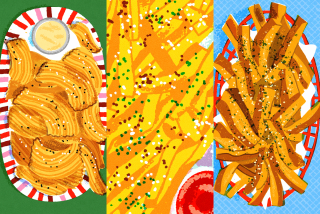Home of the free, land of the hot dog
- Share via
Between Memorial Day and Labor Day, about 7 billion hot dogs will be consumed in the United States. On the Fourth of July alone, 150 million will be gobbled by Americans celebrating the birth of the nation. Not that the Founding Fathers polished off batches of them after putting the final touches on the Declaration of Independence. Hot dogs as we know them today did not exist until nearly 100 years later. But they really are an American creation, and in a way the product of social and economic forces that the founders unleashed, wittingly or otherwise.
Why hot dogs? After all, they are just small sausages made of meat (and other things in the cheapest of them) sold for as low as a dollar or two a package. Most Americans think of them as common, cheap and somewhat suspect. Food connoisseurs Thomas Jefferson and Benjamin Franklin would have considered hot dogs to be the lowest of foods.
But if the nation’s founders were taken to a ballgame today where they could eat hot dogs (picture George Washington chomping down on a condiment-laden one with his “wooden” teeth), they would surely recognize the meaning inherent in them. Jefferson probably would be suspicious of a mass-produced commercial sausage since it was not made at home or in a small shop by an artisan. Alexander Hamilton (not a signer of the Declaration of Independence but a founder nonetheless) would have liked the industrial production and commerce as builders of the nation’s wealth. Franklin no doubt would have been fascinated by the science and technology used in the manufacturing process.
Hot dogs came to be part of American popular culture because of history and the sometimes mysterious workings of popular culture. But as much as anything, hot dogs just plain taste good. Dressed in various toppings or even relatively plain with mustard and maybe onions (but never ketchup), the combination of chewy meat, fat, salt and seasonings with a white bread bun is irresistible.
So they seemed to Americans when German immigrants brought their sausage culture (and beer) in the mid-19th century. Later, German, East European Jewish, Greek and Italian vendors, among others, sold them on the streets and in the new venues of affordable mass entertainment such as Coney Island and baseball parks. In the new Industrial Age, hot dogs seemed just right to Americans: cheap, meaty and served fast.
The founders also would have recognized some of their ideals for a new nation in the hot dog story: American individualism, can-do spirit and egalitarianism. Although hot dogs are mass-produced, people have adapted them to their individual tastes and then into something that becomes iconic versions of their city or region.
As just a sampling, you’ll find a “garden on a bun in Chicago,” deep-fried rippers and Italian hot dogs in New Jersey, cream cheese ones in Seattle and Sonoran hot dogs in Arizona and across the Southwest. The Sonoran dogs and Los Angeles’ “danger dogs” are bacon-wrapped and cooked on griddles with slight differences in toppings. They both come by way of Latino immigrants, just as the original versions were from German immigrants. All of these are variations created by small-scale hot dog hawkers. Even the decor of many carts and stands operated by small entrepreneurs who hope to rise economically reflects this liberty to exist and operate in America.
As food, hot dogs are a symbol and means of social integration. Eating one with fellow enthusiasts from all walks of life is an act of community solidarity, especially at a ballpark with fellow fans. And it is part of the lovely myth of social equality that Americans hold dear. As one authority, Beverley Pink of Pink’s Hot Dogs in Los Angeles, likes to say, customers from a cross-section of society — the minimum-wage worker and the celebrity in his fancy car — all stand in line to order their food and get the same dish.
Jefferson would have liked the idea of small communities of equals (his slaves excepted) standing in line — his White House dinners were like that. But Hamilton would never have descended from his Rolls-Royce. Who was more American and who would have loved hot dogs more?
Bruce Kraig, founding president of Culinary Historians of Chicago, is coauthor of “Man Bites Dog: Hot Dog Culture in America.”
More to Read
A cure for the common opinion
Get thought-provoking perspectives with our weekly newsletter.
You may occasionally receive promotional content from the Los Angeles Times.









